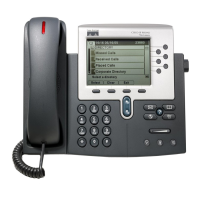Chapter 1 An Overview of the Cisco IP Phone
Understanding the Requirements for Installing and Configuring the Cisco IP Phone
1-14
Cisco IP Phone Administration Guide for Cisco CallManager 3.2, Cisco IP Phones 7960/7940/7910
78-10453-04
9. Configure the phone features such
as call waiting, call forward, call
park, and call pickup.
Provides enhanced telephony
functionality.
See the “Configuring Cisco
IP Phones in
Cisco CallManager” section
on page 6-2 and the
Cisco CallManager
Administration Guide.
10. Modify button templates. Provides customized phone
buttons.
See the “Modifying Phone
Button Templates” section
on page 6-5.
11. Configure Cisco IP phone
services.
Allows users to quickly access
information such as weather,
stocks, quote of the day or any
Web-based information using
extensible markup language
(XML).
See the “Setting Up User
Services” section on
page 6-8 or the
Cisco CallManager
Administration Guide.
12. Configure corporate directories. Integrates with a LDAP3
standard directory, enabling
users to search through a
corporate directory.
See the “Configuring
Corporate Directories”
section on page 6-8 or the
Cisco CallManager
Administration Guide.
13. Add users to Cisco CallManager. Associates a user with a
phone, enabling access to the
User Options web-based
application where users set up
features such as call
forwarding and speed dial, and
subscribe to services.
See Chapter 6, “Configuring
Cisco IP Phones, Users, and
Features in
Cisco CallManager” and the
Cisco CallManager
Administration Guide or
context-sensitive help.
14. Provide information to end users
about how to user their phone and
how to configure their phone
options.
Ensures users have adequate
information to successfully
use their Cisco IP Phone.
See the “Setting Up User
Services” section on
page 6-8.
Table 1-2 Overview of Configuration Procedures for the Cisco IP Phone (continued)
Required Task Purpose For More Information

